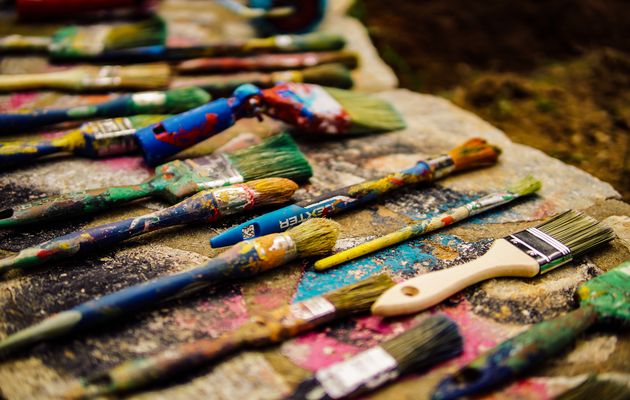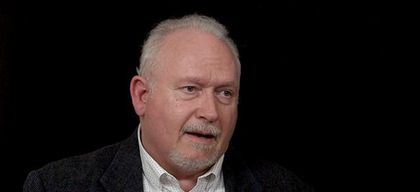Charles David Kelley, painter and president of Bridge Builders International, examines the convergence of art, culture, and faith from a Biblical perspective.
 Photo: Yannis Papanastasopoulos. Unsplash (CC0).
Photo: Yannis Papanastasopoulos. Unsplash (CC0).
Throughout history, the arts in all their forms have mirrored cultural change, and even injected voice into the theological understanding.
What does God say about art and artists? Charles David Kelley, president of Bridge Builders International and painter, examined the convergence of art, culture, and faith from a Biblical perspective, in an interview during the European Leadership Forum in Wisla, Poland.
Kelley believed that quality is key in Christian art: “if we are going to present art that glorifies God, it must be of the highest quality possible”, because “if my artwork is medium or bad, and I say it is Christian, that is horrible”.
The President of Bridge Builders International said that “the purpose of art in Scriptures, is the purpose of God in the universe, because the first artist is the Lord God, He is a Creator, and creativity is a characteristic of every artist”.
Additionally, Kelley explained that “the three best examples of the use of art in Scriptures are the Creation of the universe, the tabernacle, and the temple”.
“An artist, showing work that speaks to the soul, actually reduces the barriers and opens possibilities for discussions and relationships that were not otherwise possible”, he pointed out.
Art is important in evangelism because it “goes right underneath the presuppositions of the intellectual, who has already concluded that Christianity is irrelevant”.
Kelley emphasized that “Christian artists need to be included in the planning process”, because “they are creative people, and are used to solving problems and meeting needs in fresh ways”.
“The biggest objections that non-Christians have are not theological, but cultural, and churches do not know it, let alone do they know how to try to develop ways to get beyond that”, he concluded.
Read the interview below.
 Charles David Kelley, President of Bridge Builders International and painter. / FOCL.
Charles David Kelley, President of Bridge Builders International and painter. / FOCL.Question. What does it mean for an artist to create 'Christian art'?
Answer. There is an interesting dialogue about the topic of Christian art, Christian artist, art that is Christian, or simply made by Christians, or some Christians would say that they are followers of Jesus, and the art they make, whatever they make, they make it for the glory of God, whether or not the topic is religious.
I am a landscape painter, I paint mountains, seas, forests. I have seen thousands of beautiful landscapes, created by God. Not one tree has a Bible verse written on it. There is no one mountain that has the word “John 3:16” written on it.
You do not need to see the whole thing in order to understand the beauty and importance of it.
My landscape is a Christian art, I am a Christian, I follow Jesus, I am creating something that was created y God; I want to make art that glorifies God.
Sometimes my art will have a specific message, and if my piece is good, I want people to see it. But, if my artwork is medium or bad, and I say it is Christian, that is horrible.
One of the things that is happening in the world of art, is that secular artists laugh at Christian artists because of the lack of quality. They see that Christian artists are painting stuff that is too pretty to be beautiful, sweet but not thoughtful, not provocative.
I come from this subculture that value traditional Christian art, I understand that, but if we are going to present art that glorifies God, it must be of the highest quality possible.
Q. What are the purposes of art in Scripture?
A. If we look at the purpose of art in Scriptures, we look at the purpose of God in the universe, because the first artist is the Lord God, He is a Creator, and creativity is a characteristic of every artist.
We are the Creation, artists create creations, so we are the objects of His art. All nature represents the objects of the art of God. God created the first day and said: “it is good”, that is what an artist hopes to say, when working on a project.
The second day, He also said it is good, and when God says something is good, it is really good, it is not just OK. And He continued until the sixth day, when humans were created in God image after His likeness, for His Glory; God said it is very good and He rested.
God created people with His image, who therefore have the capacity to also create, so that from the very beginning art has been present in Scriptures, even before the sun. On the first day of Creation, God said it is good.
We see, in utilitarian ways, that, when the tabernacle was being built in the wilderness, God set part craftsmen, carpenters, jewellers, goldsmiths, people who have artistic gifts.
In fact, the first time in the Scriptures that it is mentioned that someone is directed or filled by the Spirit, it is an artist.
The tabernacle was not just a useful place, it was a beautiful place, because it is fitting for a place of worship to be beautiful, not just because it should be used, but because it reflects the beauty of a beautiful God.
The same thing happened with building the Solomon temple, and the artistic expressions, examples that are much more elaborated than the tabernacle, which once again reveal the high priority, in Gods mind, in Gods heart, for beauty, not just because it is useful, but because it is intrinsically good.
I would then say, that the three best examples of the use of art in Scriptures are the Creation of the universe, the tabernacle, and the temple.
Q. What role can Christian art play in apologetics and evangelism?
A. All believers are called to be salt and light in society, by using their gifts and talents to meet needs and solve problems.
Sometimes, the problems need to be addressed in such creative ways that society actually understand that there are issues that must be tackled.
Artists have a unique way of communicating important concepts without words, and that is incredible deep and important.
When one stands in front of a great painting, and the reaction is : “Ahh”, What has happened?: something from the artist, through the work, has penetrated the spirit, the soul of the viewer, and he does not have words for it, but it is deeper than the mind, and it is from that place that decisions are made.
It is from that place that values are also changed, it is from there that willingness to engage with the gospel message is changed from stubborn refusal to open awareness.
An artist, through a creative exhibition, by showing work that speaks to the soul, actually reduces the barriers and opens possibilities for discussions and relationships that were not otherwise possible.
Andrew Fellows, an artist and apologist, says that art is the new apologetics for Europe. He is basically saying that the average intellectual European mind is closed to intellectual discussion.
Then, how do you gain access to it?, one way is through art, because it goes right underneath the presuppositions of the intellectual, who has already concluded that Christianity is irrelevant.
But the message through art goes underneath that, and now there is dialogue.
Q. What important roles can Christian artists play in the church?
A. Christian artists can play numerous important roles. The natural role is what are they artistic gifts and in what way can they be applied.
The church leadership needs to know what those gifts are, and to keep in mind that, when they are planning their services, they know they have certain musicians that can do this, and this photographer that maybe be willing to create a special exhibition on this particular topic, and the people in the community will come because it is so well done.
Another important role that Christian artists can play in the church is to be included in the planning process.
They are creative people, and creative people are used to solving problems and meeting needs in fresh ways. In society, the needs are continually changing, the culture is changing, the play field is not longer even.
Artists are in touch with culture, they understand the cultural differences between the church and society.
The late Joe Aldrich used to say that the biggest differences between community and the churches are not theology, but culture; and the biggest objections that non-Christians have from involving with the church, are not theological, but cultural, and churches do not know it, let alone do they know how to try to develop ways to get beyond that.
ABOUT CHARLES DAVID KELLEY
Charles David Kelley is Latvian-American, citizen of both countries. Born in Los Angeles, he has lived in Oregon since 1980.
His professional training is in Bible, theology, and missiology. He began ministering in Latvia in 1985. Before founding Bridge Builders International, an Oregon based mission that focuses on Latvia, in 1994, Charles served in pastoral ministry in California, Texas, and Oregon for 21 years.
He is chairman and director of BBI’s Latvian affiliate, “Partners.” He serves as Dean of International Relations at Baltic Pastoral Institute in Riga. Charles is founder of the Imago Dei Artists Network in Latvia and co-founder of the imagiNATIONS Annual Art Festival for Estonia and Latvia.
He is a member of the Arts Centre Group in London and is the LausanneARTS Advocate at Large for Europe. Charles is an author, pianist, and painter, having studied at the feet of two masters, professors both, from the Latvian Academy of the Arts.
He lives in Latvia 4-5 months per year. He has been married to Nancy for 40 years and has four grown children and nine young grandchildren.

Las opiniones vertidas por nuestros colaboradores se realizan a nivel personal, pudiendo coincidir o no con la postura de la dirección de Protestante Digital.
Si quieres comentar o